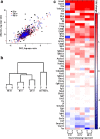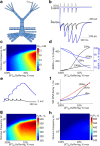Astrocytic dysfunction in epileptogenesis: consequence of altered potassium and glutamate homeostasis?
- PMID: 19710312
- PMCID: PMC2875068
- DOI: 10.1523/JNEUROSCI.2323-09.2009
Astrocytic dysfunction in epileptogenesis: consequence of altered potassium and glutamate homeostasis?
Abstract
Focal epilepsy often develops following traumatic, ischemic, or infectious brain injury. While the electrical activity of the epileptic brain is well characterized, the mechanisms underlying epileptogenesis are poorly understood. We have recently shown that in the rat neocortex, long-lasting breakdown of the blood-brain barrier (BBB) or direct exposure of the neocortex to serum-derived albumin leads to rapid upregulation of the astrocytic marker GFAP (glial fibrillary acidic protein), followed by delayed (within 4-7 d) development of an epileptic focus. We investigated the role of astrocytes in epileptogenesis in the BBB-breakdown and albumin models of epileptogenesis. We found similar, robust changes in astrocytic gene expression in the neocortex within hours following treatment with deoxycholic acid (BBB breakdown) or albumin. These changes predict reduced clearance capacity for both extracellular glutamate and potassium. Electrophysiological recordings in vitro confirmed the reduced clearance of activity-dependent accumulation of both potassium and glutamate 24 h following exposure to albumin. We used a NEURON model to simulate the consequences of reduced astrocytic uptake of potassium and glutamate on EPSPs. The model predicted that the accumulation of glutamate is associated with frequency-dependent (>100 Hz) decreased facilitation of EPSPs, while potassium accumulation leads to frequency-dependent (10-50 Hz) and NMDA-dependent synaptic facilitation. In vitro electrophysiological recordings during epileptogenesis confirmed frequency-dependent synaptic facilitation leading to seizure-like activity. Our data indicate a transcription-mediated astrocytic transformation early during epileptogenesis. We suggest that the resulting reduction in the clearance of extracellular potassium underlies frequency-dependent neuronal hyperexcitability and network synchronization.
Figures







Similar articles
-
TGF-beta receptor-mediated albumin uptake into astrocytes is involved in neocortical epileptogenesis.Brain. 2007 Feb;130(Pt 2):535-47. doi: 10.1093/brain/awl317. Epub 2006 Nov 21. Brain. 2007. PMID: 17121744
-
Regulation of astrocyte glutamate transporter-1 (GLT1) and aquaporin-4 (AQP4) expression in a model of epilepsy.Exp Neurol. 2016 Sep;283(Pt A):85-96. doi: 10.1016/j.expneurol.2016.05.003. Epub 2016 May 4. Exp Neurol. 2016. PMID: 27155358 Free PMC article.
-
Hyperglycemia reduces functional expression of astrocytic Kir4.1 channels and glial glutamate uptake.Neuroscience. 2015 Dec 3;310:216-23. doi: 10.1016/j.neuroscience.2015.09.044. Epub 2015 Sep 25. Neuroscience. 2015. PMID: 26404875 Free PMC article.
-
Inflammatory Astrocytic TGFβ Signaling Induced by Blood–Brain Barrier Dysfunction Drives Epileptogenesis.In: Noebels JL, Avoli M, Rogawski MA, Vezzani A, Delgado-Escueta AV, editors. Jasper's Basic Mechanisms of the Epilepsies. 5th edition. New York: Oxford University Press; 2024. Chapter 28. In: Noebels JL, Avoli M, Rogawski MA, Vezzani A, Delgado-Escueta AV, editors. Jasper's Basic Mechanisms of the Epilepsies. 5th edition. New York: Oxford University Press; 2024. Chapter 28. PMID: 39637183 Free Books & Documents. Review.
-
Physiological bases of the K+ and the glutamate/GABA hypotheses of epilepsy.Epilepsy Res. 2014 Aug;108(6):995-1012. doi: 10.1016/j.eplepsyres.2014.04.001. Epub 2014 Apr 21. Epilepsy Res. 2014. PMID: 24818957 Free PMC article. Review.
Cited by
-
ALS-like pathology diminishes swelling of spinal astrocytes in the SOD1 animal model.Front Cell Neurosci. 2024 Oct 10;18:1472374. doi: 10.3389/fncel.2024.1472374. eCollection 2024. Front Cell Neurosci. 2024. PMID: 39449756 Free PMC article.
-
Neuromodulation of Glial Function During Neurodegeneration.Front Cell Neurosci. 2020 Aug 21;14:278. doi: 10.3389/fncel.2020.00278. eCollection 2020. Front Cell Neurosci. 2020. PMID: 32973460 Free PMC article.
-
Inflammatory events at blood-brain barrier in neuroinflammatory and neurodegenerative disorders: implications for clinical disease.Epilepsia. 2012 Nov;53 Suppl 6(Suppl 6):45-52. doi: 10.1111/j.1528-1167.2012.03702.x. Epilepsia. 2012. PMID: 23134495 Free PMC article. Review.
-
Alpha-Pinene Decreases the Elevated Levels of Astrogliosis, Pyroptosis, and Autophagy Markers in the Hippocampus Triggered by Kainate in a Rat Model of Temporal Lobe Epilepsy.Mol Neurobiol. 2025 Feb;62(2):2264-2276. doi: 10.1007/s12035-024-04407-x. Epub 2024 Aug 3. Mol Neurobiol. 2025. PMID: 39096444
-
Transgenic Mouse Overexpressing Spermine Oxidase in Cerebrocortical Neurons: Astrocyte Dysfunction and Susceptibility to Epileptic Seizures.Biomolecules. 2022 Jan 25;12(2):204. doi: 10.3390/biom12020204. Biomolecules. 2022. PMID: 35204705 Free PMC article. Review.
References
-
- Abbott NJ, Rönnbäck L, Hansson E. Astrocyte-endothelial interactions at the blood-brain barrier. Nat Rev Neurosci. 2006;7:41–53. - PubMed
-
- Araque A, Carmignoto G, Haydon PG. Dynamic signaling between astrocytes and neurons. Annu Rev Physiol. 2001;63:795–813. - PubMed
-
- Arnth-Jensen N, Jabaudon D, Scanziani M. Cooperation between independent hippocampal synapses is controlled by glutamate uptake. Nat Neurosci. 2002;5:325–331. - PubMed
-
- Barres BA, Chun LL, Corey DP. Ion channels in vertebrate glia. Annu Rev Neurosci. 1990;13:441–474. - PubMed
Publication types
MeSH terms
Substances
Grants and funding
LinkOut - more resources
Full Text Sources
Medical
Molecular Biology Databases
Miscellaneous
